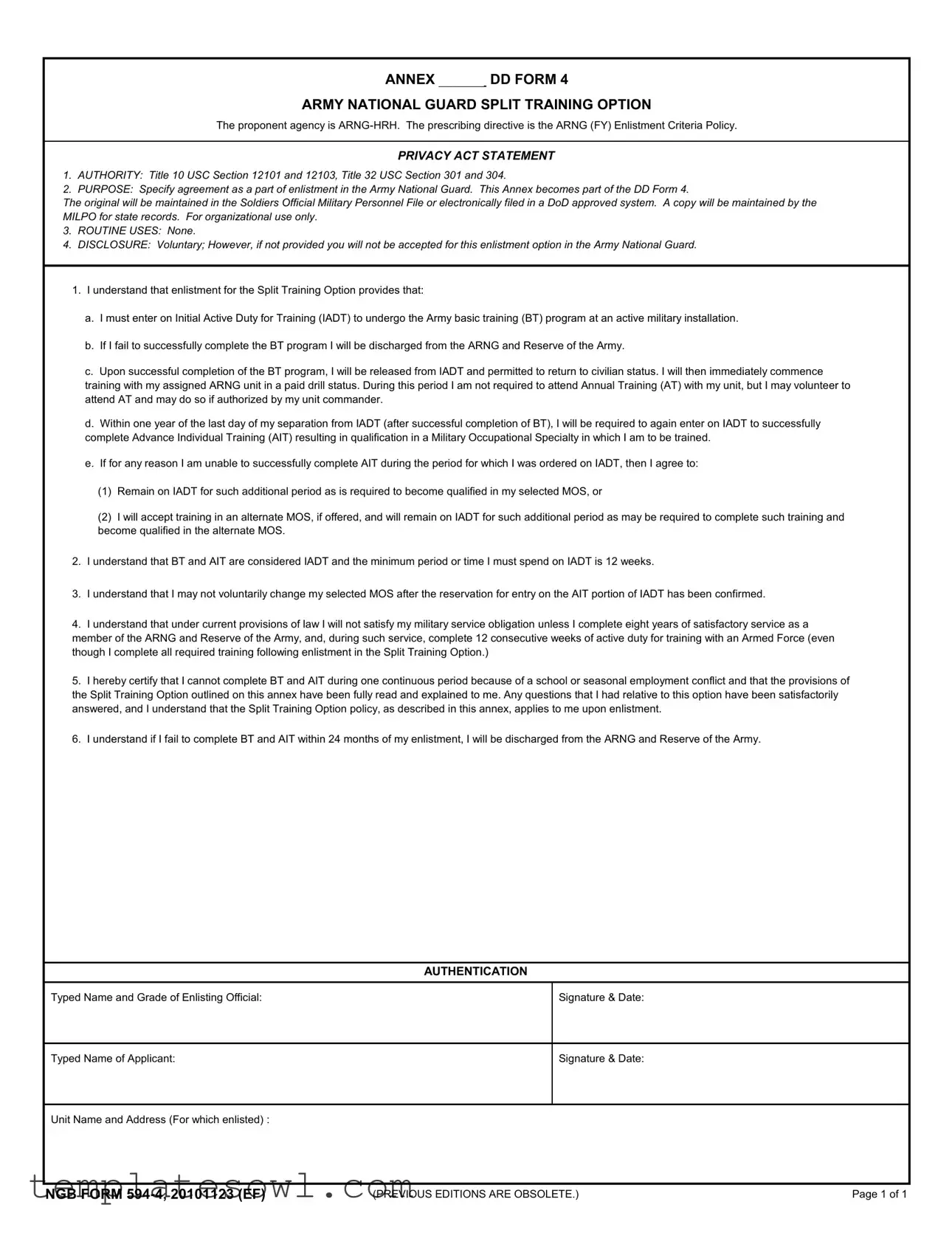ANNEX ______ DD FORM 4
ARMY NATIONAL GUARD SPLIT TRAINING OPTION
The proponent agency is ARNG-HRH. The prescribing directive is the ARNG (FY) Enlistment Criteria Policy.
PRIVACY ACT STATEMENT
1.AUTHORITY: Title 10 USC Section 12101 and 12103, Title 32 USC Section 301 and 304.
2.PURPOSE: Specify agreement as a part of enlistment in the Army National Guard. This Annex becomes part of the DD Form 4.
The original will be maintained in the Soldiers Official Military Personnel File or electronically filed in a DoD approved system. A copy will be maintained by the MILPO for state records. For organizational use only.
3.ROUTINE USES: None.
4.DISCLOSURE: Voluntary; However, if not provided you will not be accepted for this enlistment option in the Army National Guard.
1.I understand that enlistment for the Split Training Option provides that:
a.I must enter on Initial Active Duty for Training (IADT) to undergo the Army basic training (BT) program at an active military installation.
b.If I fail to successfully complete the BT program I will be discharged from the ARNG and Reserve of the Army.
c.Upon successful completion of the BT program, I will be released from IADT and permitted to return to civilian status. I will then immediately commence training with my assigned ARNG unit in a paid drill status. During this period I am not required to attend Annual Training (AT) with my unit, but I may volunteer to attend AT and may do so if authorized by my unit commander.
d.Within one year of the last day of my separation from IADT (after successful completion of BT), I will be required to again enter on IADT to successfully complete Advance Individual Training (AIT) resulting in qualification in a Military Occupational Specialty in which I am to be trained.
e.If for any reason I am unable to successfully complete AIT during the period for which I was ordered on IADT, then I agree to:
(1)Remain on IADT for such additional period as is required to become qualified in my selected MOS, or
(2)I will accept training in an alternate MOS, if offered, and will remain on IADT for such additional period as may be required to complete such training and become qualified in the alternate MOS.
2.I understand that BT and AIT are considered IADT and the minimum period or time I must spend on IADT is 12 weeks.
3.I understand that I may not voluntarily change my selected MOS after the reservation for entry on the AIT portion of IADT has been confirmed.
4.I understand that under current provisions of law I will not satisfy my military service obligation unless I complete eight years of satisfactory service as a member of the ARNG and Reserve of the Army, and, during such service, complete 12 consecutive weeks of active duty for training with an Armed Force (even though I complete all required training following enlistment in the Split Training Option.)
5.I hereby certify that I cannot complete BT and AIT during one continuous period because of a school or seasonal employment conflict and that the provisions of the Split Training Option outlined on this annex have been fully read and explained to me. Any questions that I had relative to this option have been satisfactorily answered, and I understand that the Split Training Option policy, as described in this annex, applies to me upon enlistment.
6.I understand if I fail to complete BT and AIT within 24 months of my enlistment, I will be discharged from the ARNG and Reserve of the Army.
AUTHENTICATION

